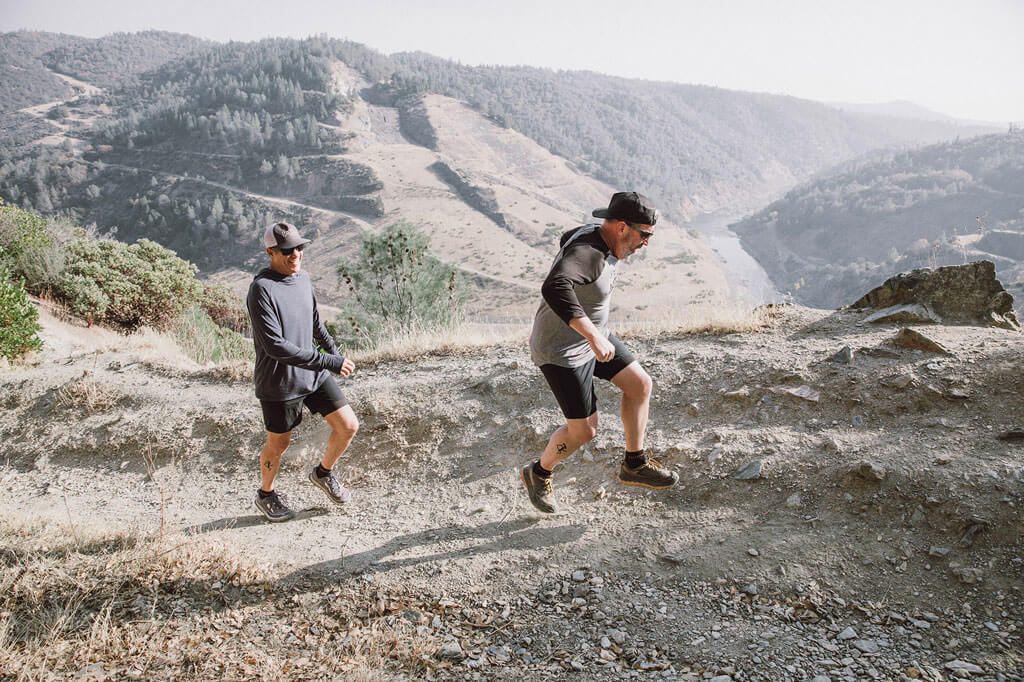The Trail Runner Nation podcast, hailed as the top trail running podcast globally, is hosted by Scott Warr and Don Freeman. They serve as weekly companions to countless runners, shining brightly within the trail running community.
Path Projects has enjoyed the unwavering friendship and support of Scott and Don since our inception in 2018 and we've previously collaborated on a TRN / PATH shirt.

Recently we sat down with Scott and Don, to hear their own trail / ultra lessons and takeaways from recording 600+ podcast episodes.
You can listen to the full conversation on the TRN podcast, or watch the full YouTube video on The Extramilest Show #62.
Takeaways and lessons learned over the years:
ABOUT RUNNING INTENSITY FOR TRAIL RUNNING
Don: With trail running, our pace changes but our workload is even. That's the art of trail running. It's keeping your workload even, no matter what trail you're on, uphill, downhill, flat your workload is even.

ABOUT MISTAKES
Don: There is a lesson to all the rules that we know, whether it comes from hydration, electrolytes, fueling, pace. It's so important to learn from your mistake and then recognize it early when it's happening to you so that you don't reproduce it. And that's what I think makes a successful veteran runner.
ABOUT FALLING:
Scott: Something that I learned early on is how to fall properly. Don't try to resist the fall and try not to brace yourself with your hands as you go down but kind of roll with it. Knowing that you're going to fall and anticipate the fall and then roll with the fall was one of the early lessons I learned.

RUNNING TRAILS VS ROAD
Don: There is a lot of mental energy that we use as trail runners to pick our course to watch each and every footstep, where it needs to go, where there's a route, where there's a rock. You need to be engaged every step you know.
Scott: There are a couple reasons why you don't shuffle on a trail one. You don't want to cause the cloud dust for the guy behind you, or gal behind you. But secondly if you're shuffling that little pebble can take you out.

INTRODUCTION TO TRAIL RUNNING
Scott: For road running, you can go down to the sports store. Get some shoes and go out to start running on the roads. But for trail running, the typical evolution of becoming a trail runner is that someone invited you and that brings up that whole community atmosphere that we all just love trail running for. It's someone inviting you to try something and then you end up being part of the group.
TRAIL RUNNING COMMUNITY
Don: You know when there's risk in the world people join together, they get strength in numbers. They have security with it. There are some inherent risk with trails, like getting lost, falling and hitting your head, twisting an ankle, being stranded out there, any number of things. That's why our community gets strong is because there is a risk that's out there. People become cohesive as a unit just because of risk and I think that you know there is that with the trail and not as much with the road.

SMALL STEPS TO INTRODUCE RUNNERS TO THE TRAILS
You can also go to your local running store and just ask them if they know where the clubs are and they can often guide you in the right direction.
If you show up to that store or you show up to the trailhead for one of those trail runs they're going to put their arms around you and make you feel welcome.
There are different apps out there that can help you find local trails, such as Strava Segment finder, All Trails, etc.
TRAIL / ULTRA RUNNING GEAR
Scott: A handheld water bottle. I personally don’t like hydration vests, but that’s kind of the gear now. You could get a good hydration vest that you can carry an extra jacket or your beverage of choice.

Don: Anti-chafing lube like squirrels nut butter can help solve the problem of chafing on longer distance runs.
ONE OF HIS BIGGEST AHA MOMENTS
SCOTT: We did a big review on James Clear's Atomic Habits book and one of the things that changed my life is the whole thing about identity.
When you see me in a grocery store, you might think “boy that guy probably needs to hit the gym a little bit and maybe try to go out and do a walk around the block a few times”. My body is not a runner's body and for years, even after running Western States 100, I did not think I was a runner. I didn't picture myself, I didn't identify as a runner. I felt like an imposter.

After reading that book and internalizing that principle, I thought you know what, I don't need to look like a runner to identify as a runner. I am a runner and that changed a lot of things in my life because once I identified myself as a runner. What do runners do? They wake up in the morning and they go for a run or they finish their day and they go for a run and because they did their daily run, then their identity is reinforced and it's this circle. Regardless of whether it's a runner, if you identify as a good dad, or a good mom, or a good brother or a good friend or ah, a hard worker once you identify yourself as that you're.
Actions are going to follow that identity and reinforce the identity. It's just a circle. That's just going to make you just a better person.
THE MENTAL SIDE OF RUNNING
Don: The whole sport of trail and ultra running is wrapped up in just that nugget, that moment, that internal discussion that you have with yourself:

There are so many things that are around the mental game. The ball that bounces around inside your cranium fascinates me. It can take you out of a race. It can put you into a race. It can do so many things and it's that piece and really I think that's what the long miles are about.
You'll have a wonderful relationship. You'll get to learn who you really are, you'll get to meet the inside of you. For some people that person is a mystery. They've never met that person. They've never walked in those shoes. They've never struggled in that moment. They've never been in a spot where they had to, because life is pretty comfortable and in first world environments and if you're cold you know you turn up the thermostat and if you're hungry, you open the fridge but when you're out there in a long run. There's nobody but you and it is up to you to get to the next spot. Whatever that spot might be and you've got to talk to yourself about it. You've got to think your way through it. You got to troubleshoot. I love that part.
ADVICE FOR RUNNERS LOOKING TO RUN FURTHER / LONGER / CONSISTENT

Don: You can't do something for a long time. That's hard, so find where you feel comfortable. Stay in that zone and then watch the magic happen because the body is very good at doing things for a long time if you set it up right? As long as you don't sabotage yourself, you can sabotage yourself with pace and electrolytes, hydration and not having the right proper footwear, having a blister, not having chafage prevention stuff. There's a lot of ways to sabotage yourself. So don't sabotage yourself, go make it easy and go long!
Scott: What I do that really helps me is I actually block off on my work calendar times for runs. Then other people can't sabotage that time and that's been a real real help for me.
DON’T BE SO HARD ON YOURSELF!

Don: People should be compassionate with themselves, don't be so hard on yourself. There are peaks and valleys in life and one of the things we've learned talking to people is there's such a thing as emotional stress and that weighs on you.
You can't always measure how well you're doing by looking at a watch. Sometimes you just need to go out there and enjoy it and be compassionate with yourself. Let it be an easy run, a slow run. Don't judge yourself and just enjoy yourself. That is probably one of the most important takeaways that I've learned.
FAVORITE PATH PROJECTS GEAR

Scott:
I never run without my Crest PX short!
I am most comfortable at home in my Killam PX pant and Pyrenees hoodie.
 |
 |
| Shop Killam PX pant | Shop Pyrenees Hoodie |
Listen to the full podcast episode HERE on Trail Runner Nation.
Or watch the full video below:







